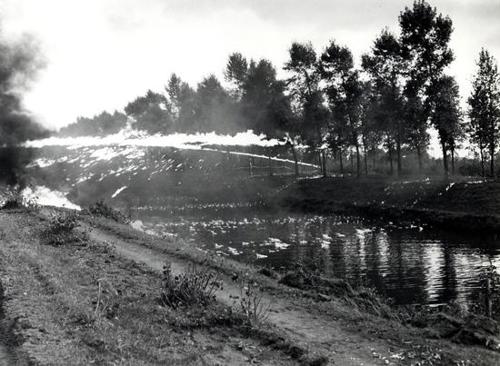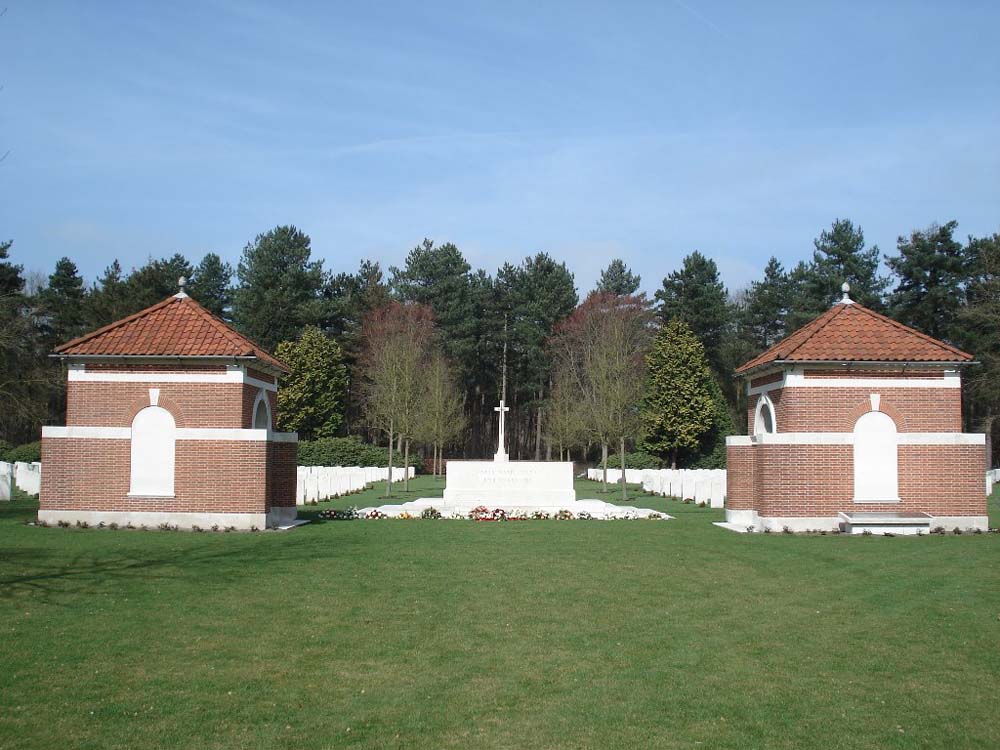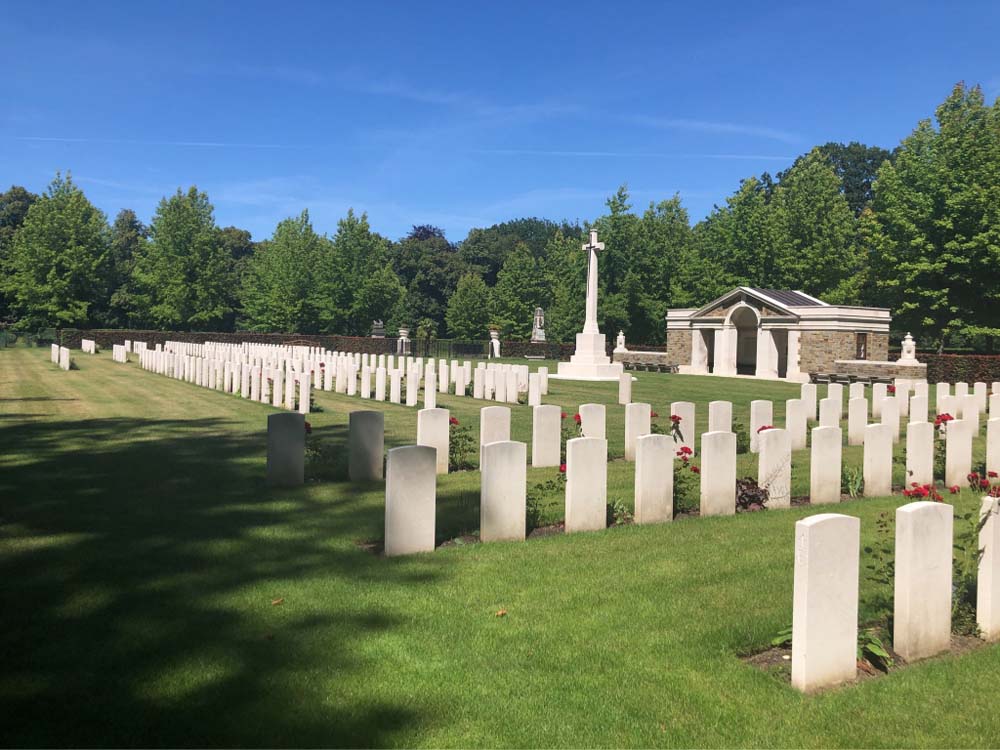30 September 2024
Legacy of Liberation: The Battle of the Scheldt 80 years on
Discover the story of the Battle of the Scheldt and the men who fought there 80 years on from this decisive Second World War clash.
The Battle of the Scheldt
Image: Map of the Battle of the Scheldt (Wikimedia Commons)
What was the Battle of the Scheldt?
The Battle of the Scheldt was a military operation in Northern Belgium and southwest Netherlands. It took place between 2 October – 8 November 1944.
It was one of the largest, deadliest battles to take place on Dutch soil during the Second World War.
Why did the Battle of the Scheldt take place?
Following the stunning successes of D-Day and victory in the Battle of Normandy, the Allies had to decide the best course of action to bring an end to the war in Europe.
Millions of Allied personnel were now in France. Keeping the vital supplies of food, ammunition, medical equipment and so on flowing was also a top priority.
While American and British armies prepared to push into the Netherlands for Operation Market Garden, the First Canadian Army had been tasked with securing and opening the channel ports. Many were still being held by German occupiers.
By October, the Canadians had liberated the port cities of Boulogne, Cap Gris Nez, Calais, and Dunkirk.
Meanwhile, Operation Market Garden had been a failure. No swift conclusion to the war in Europe would happen in 1944.
For the Allies, capturing another major port became imperative to ensure adequate supplies through the winter months.
Antwerp, Europe’s second largest port, was captured by the British Second Army on 4 September 1944, ahead of Market Garden. However, the canals, rivers, and waterways around Antwerp toward the North Sea coast were still in German hands.
The water route to Antwerp meant ships had to pass through an area known as the Scheldt Estuary.
No Allied shipping could safely pass through unless it was cleared. The Wehrmacht had reinforced the waterways of the Scheldt and Walcheren Island in the river’s mouth.
Who fought at the Battle of the Scheldt?

Image: Buffalo amphibious transport vehicles bring Canadian soldiers ashore at the Battle of the Scheldt (© Library and Archives Canada PA-136754)
Roughly 135,000 Allied soldiers fought at the Battle of the Scheldt.
First Canadian Army, under the command of Lieutenant-General Guy Simonds, was tasked with clearing the Scheldt. As its name suggests, this was a predominantly Canadian unit, but within First Canadian Army’s makeup were British, American, Free French, and Polish servicemen.
Facing the Canadians were some 90,000 battle-hardened Wehrmacht troops. The Scheldt garrisons had been reinforced following Operation Market Garden too. Dislodging them would not be easy.
What happened At the Battle of the Scheldt?
The Battle of the Scheldt plan had four distinct objectives:
- Clear the area north of Antwerp & secure access to South Beveland
- Clear an area of land called the Breskens Pocket behind the Leopold Canal
- Capture South Beveland
- Capture Walcheren Island
The Canadians Advance
 Image: Canadian soldiers on the move near the Leopold Canal (© Library and Archives Canada PA-130255)
Image: Canadian soldiers on the move near the Leopold Canal (© Library and Archives Canada PA-130255)
Early in October 1944, the 2nd Canadian Infantry Division started its push north of Antwerp. At the same time, the 3rd Canadian Infantry Division and 4th Canadian Infantry Division began attacking the Leopold Canal.
The Wehrmacht facing the Canadians was well-dug-in and well-motivated. The geography of the Scheldt Estuary also made attacking difficult. The formidable defensive emplacements coupled with dreary, rainy weather, gave the Battle of the Scheldt the character of a First World War offensive.
For instance, the 2nd Canadian Division attacking at South Beveland had to do so over open, flooded ground, making their experience akin to that of their forefathers on the Western Front.
Such was the devastation meted out to the advancing Canadians in South Beveland that the open ground they crossed was nicknamed “The Coffin”. Hundreds of Canadian soldiers were cut down by machine-gun, rifle and artillery fire.
Casualties were so bad that 56 of the 145 members of the Canadian Black Watch at The Coffin were killed. A further 27 were captured or wounded.
South Beveland Secured
Field Marshal Sir Bernard Montgomery, overall commander of the First Canadian and Second British Armies made the capture of the Scheldt the army’s top priority.
Woensdrecht, a village at the entrance to South Beveland, had been captured at heavy cost on October 16.
With Monty’s full backing, the Canadian assault on the Scheldt continued. Lieutenant-General Simonds ordered the 4th Canadian Armed Division to move north of Scheldt itself and push towards Bergen-op-Zoom.
By 24 October, South Beveland had finally been breached. With the assistance of an amphibious landing undertaken by the British 52nd Division on October 24, the 2nd Canadian Infantry was moving into South Beveland in force.
By October 31, the area was in Allied hands.
Crossing the Leopold Canal
 Image: Crocodile Tank shoots a jet of napalm across the Leopold Canal (© Library and Archives Canada PA-131240)
Image: Crocodile Tank shoots a jet of napalm across the Leopold Canal (© Library and Archives Canada PA-131240)
Fighting raged across the Scheldt’s southern banks while the attack on South Beveland was underway.
The 3rd Canadian Division had run into tough, determined German defences while it attempted to cross the Leopold Canal. Crossing this waterway would take the 3rd Canadian Division into the Breskens Pocket: an area of land occupied by the Wehrmacht and one of the Canadians’ key objectives.
From October 6th, the men of 3rd Canadian Division had fought and paid dearly to build a slim bridgehead across the canal. Opposition remained stiff until an amphibious assault broke German defences on October 9.
With Canadian infantry and armour crossing the Leopold Canal in greater and greater numbers, the Germans withdrew to concrete bunkers and defensive networks closer to the North Sea Coast. The Bresken Pocket was closed.
Even so, it would take until November 3 for the southern Scheldt to be captured fully.
Capturing Walcheren Island

Image: A Canadian Field Hospital set up on the beach of Walcheren Island (Wikimedia Commons)
With South Beveland in Allied hands, the Leopold Canal crossed, and its defences overcome, only one obstacle remained: Walcheren.
The island had been turned into a killing zone by its defenders. Bristling with bunkers, machine-gun nests, mortar pits and more defences, Walcheren was also only accessible by a narrow causeway from South Beveland.
What’s more, the flats around the causeway were saturated with shallow seawater. It was too deep for Canadian soldiers to wade through but was also not deep enough for their assault boats.
Walcheren was subjected to a three-way attack:
- Across the causeway
- Across the Scheldt from the south
- From the sea from the West
The Royal Air Force pounded Walcheren ahead of the assault, destroying the island’s dykes, making the battlefield accessible to amphibious landing craft.
On October 31, the Canadians attacked the causeway. After a bloody struggle, they forged a foothold which the 52nd British Division was able to exploit with its attacks.
The combination of the three-way assault proved too much for Walcheren’s Wehrmacht defenders. On November 6, Middelburg, Walcheren’s capital, was seized. By 8 November, all opposition has ceased.
The End of the Battle of the Scheldt
While the infantry and Brits had been clearing Walcheren, the tanks and armoured fighting vehicles of the 4th Canadian Armoured Division had advanced beyond Bergen-op-Zoom to towns and villages on Walcheren’s northeast flank.
Several German vessels were sunk at anchor when the Canadian tanks reached Zijpe harbour.
Casualties of the Battle of the Scheldt
Despite taking more than 40,000 prisoners, and clearing the Scheldt Estuary as ordered, the Allies sustained heavy losses.
The Canadians, who had been the major Allied fighting force at the Battle of the Scheldt, suffered most.
First Canadian Army had suffered around 12,900 casualties (killed, missing or wounded) at the Scheldt, half of which were Canadian nationals.
Losses for the Canadians at the Scheldt have even drawn comparisons to the slaughter witnessed at the Great War’s Western Front battles.
Fallen soldiers of the Battle of the Scheldt
The Canadian and Allied servicemen who fought and fell at the Battle of the Scheldt are perpetually commemorated by Commonwealth War Graves.
Our war cemeteries and memorials give each of these men a permanent point of commemoration and remembrance so that their sacrifice is never forgotten.
Here, we share some stories of a small handful of the Canadians killed during the Battle of the Scheldt.
Captain John “Jack” Lawrence Murdoch
 Image: Captain Jack Lawrence with the Canadian Rowing Team (Public Domain)
Image: Captain Jack Lawrence with the Canadian Rowing Team (Public Domain)
Born on 18 July 1908, Captain John “Jack” Murdoch was a highly skilled and respected rower who represented Canada at the 1928 Summer Olympic Games in Amsterdam.
With his crew, Jack competed in the eights and together there we able to bring a Bronze Medal back to Canada, finishing behind the USA and Great Britain in the final.
Come the Second World War, Jack enlisted in the army, joining the Royal Canadian Artillery, 13th Field Regiment.
Sadly, Jack was killed in action at the Battle of the Scheldt, bringing his sporting career to an end.
Lieutenant Edward Francis Arab
 Image: Lieutenant Edward Arab (copyright unknown)
Image: Lieutenant Edward Arab (copyright unknown)
A native of Halifax, Nova Scotia, Edward Arab was born on 6 September to parents Louis and Senora Arab.
Edward was educated at St. Patrick’s High School followed by Dalhousie University where he studied law. Edward as also a keen sportsman, enjoying boxing, football, and swimming at university.
While at Dalhousie, Edward also worked on the Dalhousie Gazette, Canada’s oldest college newspaper.
Upon graduation, Edward opened his own law practice in Halifax, focussing on racism and prejudice cases. He was also the founder and first president of the Canadian Lebanon Society (Edward was of Lebanese descent via his grandfather).
Edward enlisted in August 1942 and was recommended for officer training. By November, he had been commissioned as a Lieutenant.
Following further training, Edward travelled to the UK in June 1944 before joining the Lincoln and Welland Regiment in France in September.
Edward became one of the many casualties of the Battle of the Scheldt when he was killed in action on October 25, 1944.
Leading his men in an attack on German positions around Esschen and Huijbergen, Edward was wounded in the leg under heavy fire. Medics treated the wound but
Edward was killed alongside six other members of his regiment as the fire intensified.
Edward is buried at Bergen-Op-Zoom Canadian War Cemetery.
Private Christopher Cadeau
 Image: Private Christopher Cadeu (Photo courtesy of Paul Allen)
Image: Private Christopher Cadeu (Photo courtesy of Paul Allen)
Private Christopher Cadeu’s family had been settled in Quebec for centuries before his birth on April 25, 1922.
The original Cadeus arrived in Canada in the early 1700s, while his mother’s side of the family, the Colombes, had arrived in 1641.
Christopher was one of 11 children. Before he enlisted in the Canadian Army, Christopher had held several odd jobs and worked on ships on the Great Lakes and out of New York.
Christopher joined the army in November 1943. He was just 18.
Come February 1944, Christopher was training with the Canadian Armoured Corps, qualifying as a Class III (Wheeled Vehicle) Driver.
After being sent overseas, Christopher was re-mustered into the infantry. The Canadians had been taking heavy casualties in Normandy, resulting in a critical shortage of infantry.
Following this shakeup, Christopher was first sent to the Winnipeg Grenadiers, which had been reconstituted as a training battalion following the units obliteration in Hong Kong.
On 17 October 1944, Christopher was sent to Belgium before joining the Canadian Scottish Regiment.
The Canadian Scottish Regiment was involved in the battles to secure the southern bank of the Scheldt, also known as Operation Switchback.
The Canadian Scots were in the 7th Infantry Brigade so were responsible for clearing the area adjacent to the Scheldt. Christopher joined the unit on 24 Oct in Breskins after 3 weeks of fighting.
The Canadian Scots war diary for 27 Oct, the day Christopher was killed reads:
“The Coys began what was to prove to be a very difficult day:
“’A’ Coy had kept on but were now enduring painfully heavy shelling. All went well until suddenly 9 Platoon found itself fired on by machine guns at point-blank range. They were travelling along a road at the foot of a dyke and were met by a hail of fire from all sides.
“The enemy had allowed them to pass through and had then closed in. It was a well-planned and well-executed manoeuvre by the defending Paratroopers of the German Army. 9 Pl's runner, Pte Bowling, was sent back to warn Coy HQ of the situation.
“A bloody battle ensued with every ounce of fighting energy that the gallant ‘A’ Coy men possessed. 4 Canadian Scots were killed including Christopher Cadeau, 5 wounded and 40 missing.”
Operation Switchback was completed on 2 Nov, with the taking of Knocke and Heyst, the last area of Belgium to be liberated.
Christopher's time in the Canadian Scots was tragically short, only 4 days. He is buried in Adegem Canadian War Cemetery.
Thanks to Paul Allen for sharing Christopher’s story.
Where are casualties of the Battle of the Scheldt commemorated?

Bergen-Op-Zoom Canadian War Cemetery
Bergen-op-Zoom Canadian War Cemetery contains approximately 1,120 Commonwealth graves of the Second World War. Major Douglas Chapman, mentioned earlier, rests here, along with many of his men who fought and died during the Scheldt campaign.

Adegem Canadian War Cemetery
The men who lie in the Adegem Canadian War Cemetery are primarily those who fell fighting to clear the Scheldt’s southern banks. It is also home to many other Canadian servicemen who fought in other key World War Two operations with over 1,100 soldiers buried here.

Schoonselhof Cemetery
You can find more Canadian casualties from the fighting north of Antwerp in the Schoonselhof Cemetery. Of the roughly 1500 Commonwealth burials that reside at Schoonselhof, about 350 are Canadian, representing those who fell during both the First and Second World Wars.
Discover the Legacy of Liberation with Commonwealth War Graves
The Legacy of Liberation marks the 80th anniversaries of several pivotal moments during the Second World War.
From Kohima and Imphal to the D-Day Landings, the Legacy of Liberation remembers these remarkable events.
Join us to mark these historic moments. Visit The Legacy of Liberation today to learn more.


